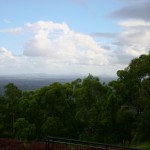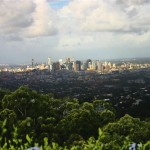This morning I’m idly reading through Facebook when one of my facebook friends describes his first forays into HDR. For those of you who are not photo-geeks, HDR stands for High Dynamic Range. It means taking several photos in quick succession of the same scene, at different exposure settings, then merging them into a single picture. My ageing Canon EOS 300D is perfectly capable of doing Auto Exposure Bracketing (AEB) — taking three photos at normal, -x and +x exposure (the value of x is up to you). It also turns out that Photoshop Elements 9, of which I am a proud owner, contains Photomerge, a plug-in that does the hard work of merging the different exposures. So, no real excuse for not giving it a try.
Doing the camera work was easy: Take a mini-tripod, use the menu to set up AEB, take a shot of a landscape photograph. (For a close-up subject, there are other – easier – ways to achieve a similar effect, such as using a fill-in flash.) The views from Mount Coot-tha were rather perfect for this purpose. Once downloaded, however, it takes absolutely ages to merge the pictures, even longer if you then mess around with manual settings. So I only did it for two sets of three, to give the general idea. For best results, click on the thumbnails to see a full-size version.
The first pair shows standard exposure, then the automatic Photomerge result. The second pair shows standard exposure, then the result of Photomerge augmented by me playing with extra layers, clipping masks etc to create a new picture. My very first exposure (ha, ha, pun intended) to HDR.



